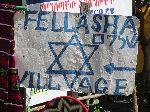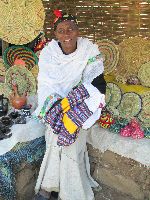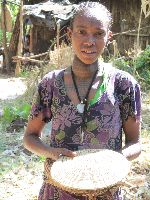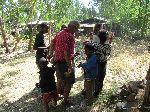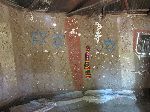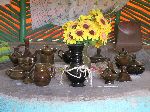| Ethiopia:
Abyssinia Adventure - Hwy 3: Simien Mountains Bicycle Africa / Ibike Tours |
|||
 |
Gondar is in the southern foothills of the Simien Mountians. To the north of Gondar, the road climbs to a high plateau and crosses the side of the Simien Mountains. The north and west sides of the Simien Mountains are noted for their dramatic escarpments. The descent on the north side of the Simien Mountains is one of the great downhill bicycle rides of the world. | ||
 |
|||
| [Graphs are built with incomplete data and are only general representations
of the topography.] |
|||
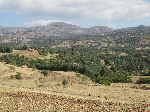
|
The first point of interest is the historically Jewish village of Woleka. It is hard to miss
because of the row of roadside curio stands selling mostly cloth and pottery. Though there is some signage referencing the villages Jewish roots we were told
that there are no long any Jews living there. The Ethiopian Jewish community referred to itself as Beta Israel, “the House of Israel.” They were predominately located in northwest Ethiopia, north of Bahir Dar. They formed marginal artisan groups with in the wider Amhara society, and were widely known as Falasha, with its connotation of “exile”. Though some used an ancient Agaw language, most of them spoke Amharic. They had been farmers until they were banned from holding land after their refusal to convert to Orthodox Christianity in the XVth century. Since then, they have been known as craftsmen (blacksmiths, weavers and potters). The religious distinction of the Beta Israel is their belief in the God of Israel. Their religious fundamentals are based on the Old Testament, plus some additional texts. Their greatest celebration and strictest observance is the Sabbath, the day on which God’s Spirit intercedes for all humanity in the redemption of sins. For Beta Israel, the special veneration of the Sabbath begins with ritual washing and the extinguishing of all fires on Friday afternoon, and continues with worship and ceremony in the synagogue on Saturday morning. The Beta Israel community's practices are described roughly equivalent to those of the wider Jewish world, except that they do not know Hebrew or follow post-exile practices. On the other hand they were influenced by a number of non-Jewish beliefs that crept into Beta Israel theology: one being the almost universal belief in the evil eye, or shadow. Many of them, especially children, wore special charms against evil spirits. They have also followed a monastic system – a practice foreign to contemporary Judaism. Nowadays, most of the Beta Israel community, around 10,000 in number, is living in Israel, where they were airlifted in 1991. Their integration into Israeli society has been far from easy. |
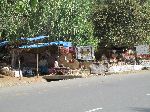
|
|
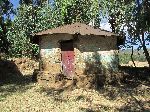 |
 There
are two buildings of interest in Woleka: A round building that is said
to have been the synagogue, worship house, and a rectangular building that is
said to have been the library. The round building has a rod iron Star of David
at the peak, a wooden Star of David inside around the central roof support, and
some rough Stars of David painted with blue paint on the walls inside and
outside. There
are two buildings of interest in Woleka: A round building that is said
to have been the synagogue, worship house, and a rectangular building that is
said to have been the library. The round building has a rod iron Star of David
at the peak, a wooden Star of David inside around the central roof support, and
some rough Stars of David painted with blue paint on the walls inside and
outside.The library building also had rustic blue Stars of David painted on the outside. We didn't have a chance to look inside. |
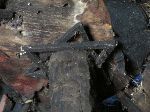 |
|
 |
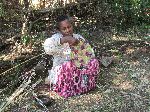

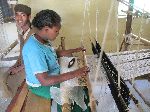
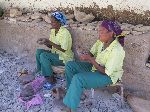 |
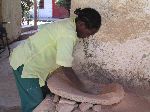 |
|
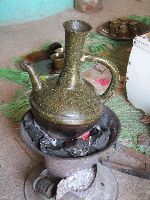 |
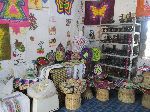 Across
the road from the
"Falasha" souvenir sellers is the Plowshares Women Craft Training Center. Across
the road from the
"Falasha" souvenir sellers is the Plowshares Women Craft Training Center.
Established in 2001, it trains mostly single mothers and disadvantaged women in spinning, weaving, pottery making, tie-dying, horticulture, animal husbandry, farming and business practices to provide them with income-generating occupations and self-sufficiency.
The Training Center's students are nominated from their local districts. When they graduate after about six months, they return to their homes. |
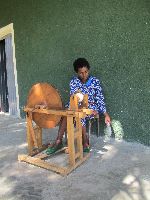 |
|
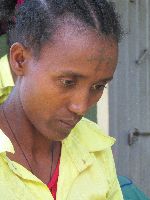 |

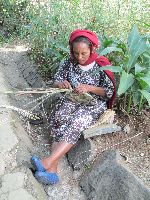
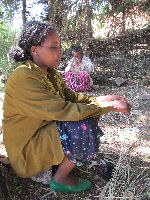
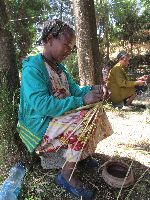 |
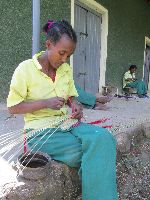 |
|
 |
These are some of the trainees at the Plowshares Women Craft Training Center. | ||
| A kilometer away, down by a river in a grove of trees, is the Jewish cemetery. | |||
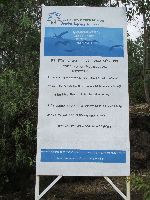 |
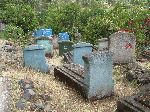
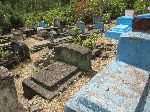
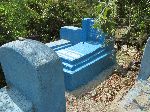
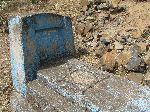 The sign was erected by the Jewish Agency for Israel and reads, "In memory of our cherished family members who dreamed of Zion and perished on their journey to Jerusalem through Sudan. May they rest in blessed memory." |
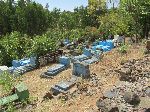 |
|
|
For half a century, until 1977, Jews from Ethiopia were permitted to freely
immigrate to Israel. After the dictator, Mengistu Haile Mariam, came to power,
this was stopped. During the decade that followed, immigration was
clandestine and managed by the Government of Israel along with The Jewish
Agency. Suffering persecution at the hands of Mengistu's Marxist regime for
their Jewish educational and Zionist activities, many of the Jewish villagers
became refugees. The first refugees from the Tigray area walked all the way to
Israel by foot with next to no aid. In 1984-1985, "Operation Moses" aided the arrival of 6,364 Jews from refugee camps in Sudan to Israel, via intermediating countries, by foot, planes, and boats. Between November 1988 and May 1991, 150,000 Ethiopian Jews moved closer to Addis Ababa, the center for Aliyah activities in Ethiopia. "Operation Solomon" was an aerial rescue of Ethiopian Jewry. In May 1991, 14,000 Ethiopian Jews arrived in Israel aboard IDF, El-Al, and Ethiopian Airlines aircraft. During the operation, the IDF, The Jewish Agency, the Joint Distribution Committee, and the Mossad joined forces. With the aid of American arbitration, the Israeli government reached a settlement with Mengistu and with the anti-government militias, allowing the rescue to take place within 34 hours. |
|||
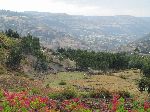
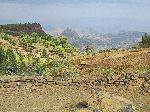

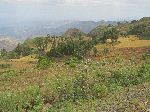 |
|||
| Gondar is the gate way to the Simien Mountains. Shortly past Woleka, the road climbs steadily for 20 kilometers. From there it continues to generally climb, but much more gradually. In several place you can look to the west over a climb to a deeply eroded landscape below. To the east is a plateau that is pretty completely under cultivation. | |||
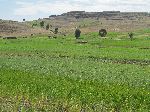

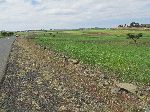 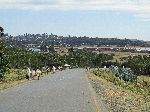 |
|||
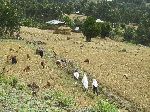 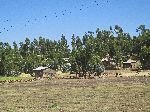 In
other parts of the Ethiopia highlands, round buildings, called turkles, were the
tradition house and are still used. In the Simien Mountains are almost all of the houses are
rectangular (left). In
other parts of the Ethiopia highlands, round buildings, called turkles, were the
tradition house and are still used. In the Simien Mountains are almost all of the houses are
rectangular (left).Traveling long distances by foot is still the norm. If you
are going to market day, it is nice to have a donkey to help with the load
(right). |
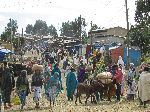 |
||
 |
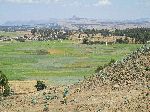 Out
of Gondar the road climbs fairly steeply for the first 20km, then more gradually
for the next 14km. By this point the change in elevation is about 800m. From
here the plateau ungulates, rarely changing more than 100 up or down in any ten
kilometer section. It often requires a double take and look in both directions
to figure out if the road is climbing, descending or flat. Out
of Gondar the road climbs fairly steeply for the first 20km, then more gradually
for the next 14km. By this point the change in elevation is about 800m. From
here the plateau ungulates, rarely changing more than 100 up or down in any ten
kilometer section. It often requires a double take and look in both directions
to figure out if the road is climbing, descending or flat. |
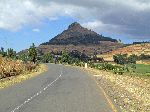 |
|
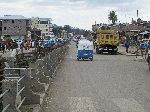
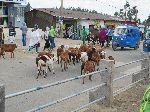
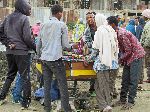
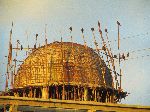
Debark is where most tourist access Simien Mountains National Park. While tourist is providing a good livelihood some people there are not enough to dominate the culture of the town. Livestock come and going to wherever they come and go to still run through the center of town. There is not enough work for the young people so the foosball tables are constantly rattling and the pool halls are often packed. |
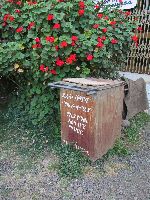 |
||
 |
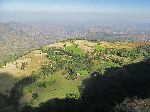
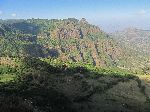

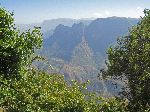 |
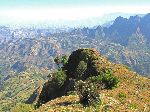 |
|
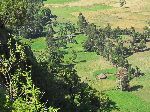 |
The Simien Mountains are known for their jagged mountain peaks, deep valleys and precipices sheer for 1,500 meters. The high plateau lords over the surrounding countryside. In place, because you are looking downward off of an escarpment, the view is similar to that from an airplane -- it may look rugged below but it is hard to determine exactly how jagged and rough because of the perspective. Needless to say the views are expansive. Many places offer 180o of view and sometimes a full there is a full 360o. |
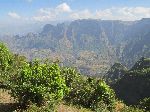 |
|
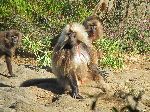 |
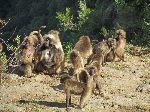 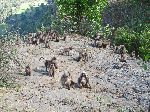 There
are several unique species of wildlife in the park. The easiest to
see is the high elevation Gelada, sometimes called the bleeding-heart monkey. It is falsely called a baboon.
It is found only in the Ethiopian highlands, with a large population in Simien
Mountains. The are gregarious, playful and not terrible concerned about being
observed by humans, but someone always has an eye on you and they will move off
quickly if you get in there comfort zone. There
are several unique species of wildlife in the park. The easiest to
see is the high elevation Gelada, sometimes called the bleeding-heart monkey. It is falsely called a baboon.
It is found only in the Ethiopian highlands, with a large population in Simien
Mountains. The are gregarious, playful and not terrible concerned about being
observed by humans, but someone always has an eye on you and they will move off
quickly if you get in there comfort zone. |
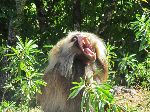 |
|
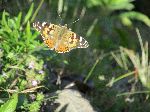 |
The park also has a large variety of big and small birds. Without much trouble I saw lammergeyers, vultures, buzzards, ravens, and bateleur. They are high and usually at a distance and moving so it is very difficult to capture a good image of any of them, so I settled for a picture of a butterfly (left). At the lower elevations, 3000m, a common bush is the wild rose
(right). The rosehips are prized by the Gelada and humans alike. |
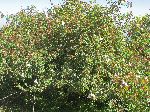 |
|


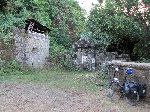
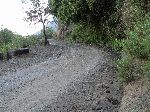 |
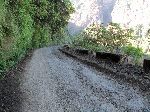 |
||
|
Between 1936 and 1940 built more than 2000km of roads in Ethiopia, much of it in
steep, mountainous terrain. The road between Debark and Zarima is probably the
last 40km of Italian rock road in the country. It is chiseled in to rock faces
and switch backs up mountains. The elevation change
is 1700m -- over a mile. At one spot the Italians built a stone rest stop at a
mountain spring. It still functions to some extent. |
|||
|
The last image to the right, shows some of the original one-lane, rock road.
It is bordered on each side with rectangular rocks of similar width butted up
against one another to define a road edge. Much more irregular cobbles are
packed between the borders to form a very durable surface, though not one that
is easy to bicycle on. Today, most of the stretch of road is packed clay and
rock. There are scattered bits and piece that are looser gravel, but altogether
the probably add up to less than one kilometer. Most of the labor to build these roads was by Ethiopians, not at free-will.
Some of the working conditions were very harsh. |
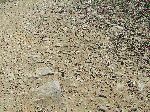 |
||
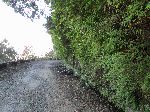


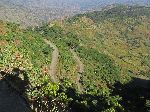 |
 |
||
| Besides marveling at the engineering, the views are astounding. At every twist and turn of the roads the is another magnificent view. | |||
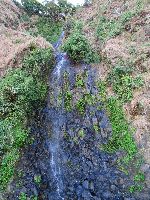 |


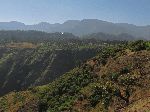
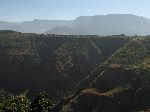
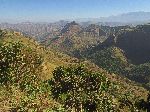
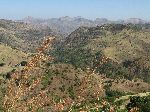
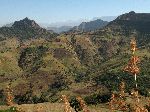
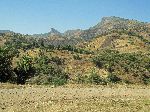 |
||
| Look down from the high escarpments of the Simien Mountains a lot of features are "flattened". At lower elevations you can get a better appreciation of how rugged, eroded and deeply cut the landscape is. | |||
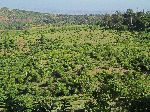 |
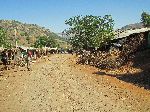
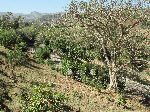 Most
of the mountainside is uninhabited and uncultivated. At a large knoll, about
half way down you start to see terracing. and shortly after that is the village
of Dib Bahir, which is bordered on one side by a tree lined stream, . Most
of the mountainside is uninhabited and uncultivated. At a large knoll, about
half way down you start to see terracing. and shortly after that is the village
of Dib Bahir, which is bordered on one side by a tree lined stream, . |
||
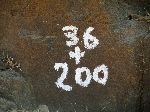 At
irregular intervals along the way are survey marks. An indication that sometime
in the next couple of years the Debark-Zarima section of Italian rock roads will
be paved as well. At
irregular intervals along the way are survey marks. An indication that sometime
in the next couple of years the Debark-Zarima section of Italian rock roads will
be paved as well.As is, the forty kilometers of continuous down hill took four hours on a bicycle, but an hour of that was stopping to take pictures and appreciate the view.. Once paved it should be a spectacular run, but it is still likely to be too steep and too tights to go full-out and it would be a waist to not make some stops to marvel at the dramatic landscape.. |
|||
|
|
|||
|
|
Unique Programs To Special Places For Memories Of A Lifetime!
"Hosted by
DreamHost - earth friendly web hosting"
|
|
